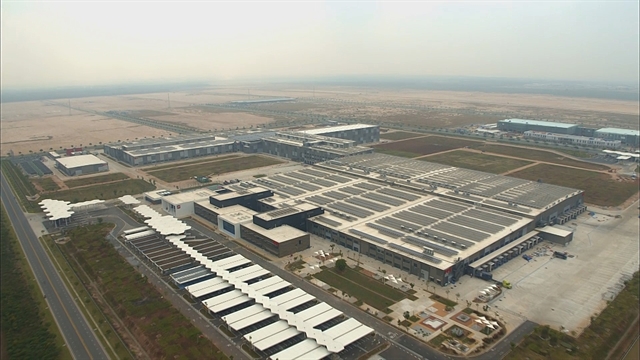 Economy
Economy

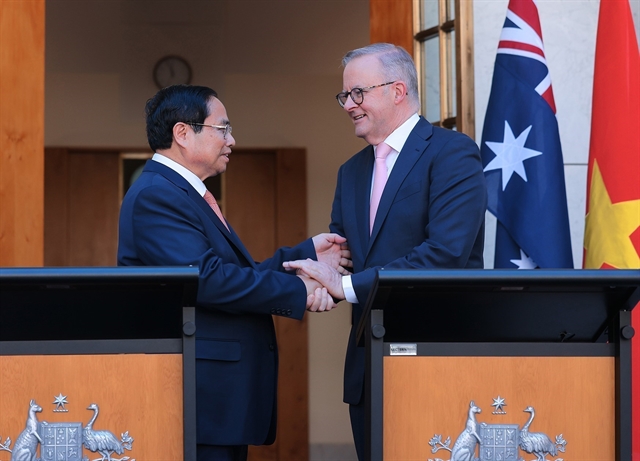
|
| Prime Minister Pham Minh Chinh and his Australian counterpart Anthony Albanese at a press conference after their talks in Canberra on March 7. — VNA/VNS Photo Dương Giang |
HCM CITY — Vệt Nam and Australia are looking to elevate their ties, possibly towards a comprehensive strategic partnership, according to a report released by HSBC’s economists.
Last week is a big one for ASEAN and Australia, as Australia is hosting ASEAN leaders in celebrating the 50th anniversary of ASEAN-Australia Dialogue Relations. Australia is a key partner for Việt Nam, as it is for other markets in the region. After Việt Nam upgraded its diplomatic relationship with the US and Japan to a “comprehensive strategic partnership” in 2023, Australia looks to be the next, with both countries having repeatedly expressed their intentions.
Indeed, both governments have repeatedly announced their intentions to develop such a relationship. Last week, Việt Nam’s prime minister Phạm Minh Chính is paying an official visit to Australia, while attending the special summit to celebrate the 50th anniversary of ASEAN-Australia Dialogue Relations along with other ASEAN leaders. From providing Việt Nam with key commodities, to exploring new areas of cooperation, we discuss how Australia has supported Việt Nam’s growth story and the potential pathways for the bilateral relationship.
The economists said that 2023 was a year full of high-level engagements for Việt Nam, as it upgraded its diplomatic relationships with both the US and Japan to “comprehensive strategic partnerships”. After signing an updated ASEAN-Australia-New Zealand Free Trade Area (AANZFTA) agreement in August 2023 and celebrating the 50th anniversary in establishing diplomatic relations, Australia looks set to be next.
Bilateral trade has boomed over the decade, more than doubling to US$13.8bn in 2023. That said, part of the expansion in trade value since the pandemic has been due to high global commodity prices. In particular, two categories stand out: coal and cotton.

|
| Vietnam is an important export market for Australian cotton farmers |
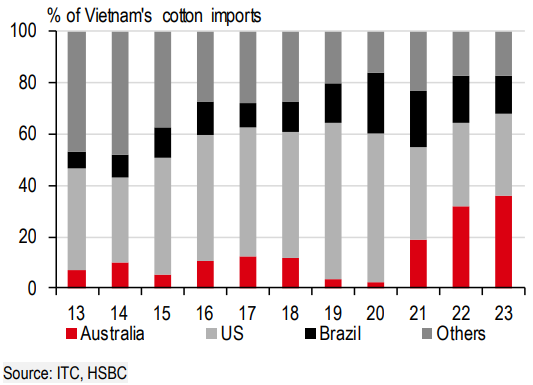
|
| Chart 3. Australia has become Vietnam’s largest source of cotton imports |
Việt Nam is now Australia’s single largest cotton export market, accounting for 40% of its total exports, doubling its share from 2020. Likewise, Australia accounts for nearly 40% of Vietnam’s cotton imports . While as a percentage of total exports (15%), Việ t Nam’s textile and garment industry has seen its share dwindle in recent years as electronics shipments have risen to 35%, it is expected to remain a tailwind for Australian cotton exporters.
That said, the boom in trade is not solely in manufacturing. Việt Nam’s structural rise in household discretionary spending has also lifted demand for certain Australian exports. In particular, Australia’s beef exports have boomed, thanks to the elimination of tariffs under the AANZFTA in 2018. What is even more encouraging is the potential of Việt Nam’s beef consumption. According to OECD-FAO, Việt Nam is expected to consume the most beef per capita in ASEAN by 2030, leaving room for further trade flows.
The relationship is not as one-sided as the above might suggest, however, as Việt Nam’s exports to Australia are also expanding. Agricultural goods are leading the way, with nuts and seafood making up the majority . Australia’s imports of cashew nuts come almost entirely from Việt Nam, according to ITC data. To further leverage trade agreements between the two countries, including AANZFTA, CPTPP, and RCEP, it will be equally important for Việt Nam to heighten quality control on its agricultural exports, especially considering Australia’s quality standards and regulations are stricter than those of the US and EU in some areas. Currently, only four fresh fruits are allowed market access into Australia: mangoes, dragon fruit, lychee, and longan, but this also indicates significant opportunities for market expansion.
Exports of goods is not the only area with potential opportunities – services are another area for expansion, albeit only gradually. ASEAN welcomed 4 million Australian tourists last year, but less than 10% of these visited Việt Nam. Part of the reason may relate to visas, as Australia is not visa-exempt and flight capacity constraints still exist. Encouragingly, an expansion in the visa exemption list is under consideration and new flight routes have been introduced. These are important initiatives, as Australian tourists tend to have a relatively high propensity to stay and spend during their holidays.
Việt Nam has the second largest rare-earth deposits in the world which remain largely untapped. Australian firms with expertise in the mining and processing industry are looking to capture this opportunity, with steady FDI inflows into the industry in ASEAN generally. For Việt Nam specifically, one such example is Blackstone Minerals, which is currently running two facilities – a nickel mine and a refinery – in Sơn La Province.
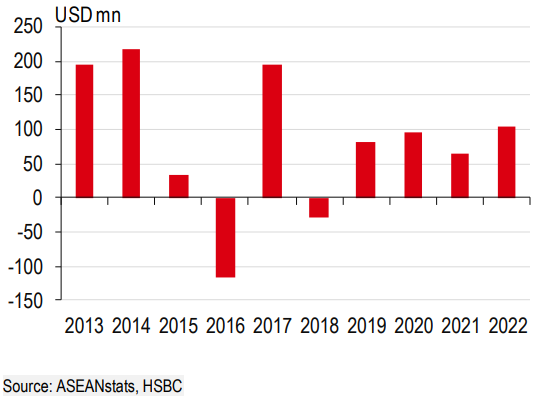
|
| Australia’s mining/quarrying FDI inflows into ASEAN has been steady |
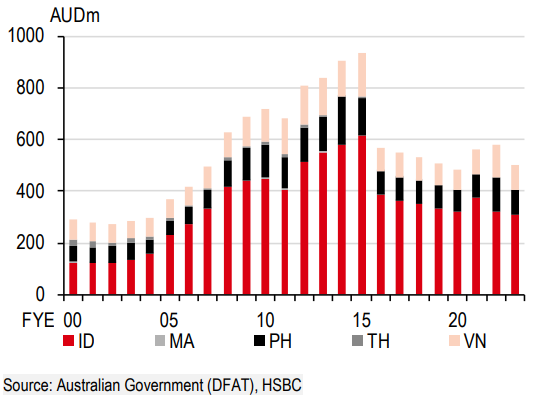
|
| Australia’s ODA to Vietnam has similarly remained steady |
Beyond critical minerals, Australia’s role as a major supplier of energy for Việt Nam puts it in a strategic position to help accelerate Vietnam’s energy transition. Subsequently, the Australian government has committed to providing related support worth AUD105million to Việt Nam.
In addition to trade and FDI, other forms of cooperation also matter. While Indonesia has long been Australia’s dominant recipient of official development assistance (ODA), Việt Nam has also seen a steady flows of development aid Meanwhile, human capital is closely intertwined. Australia long held an educational milestone of establishing the first foreign-owned international university (RMIT University) in Vietnam as early as 2000. Reflecting its ongoing commitment, the Vietnamese branch of the Royal Melbourne Institute of Technology (RMIT) was further supported by an additional AUD250m investment last year, contributing to the launch of the Innovation Hub to help support up-skilling of the workforce.
For years, Australia has supported and enabled Vietnam’s growth story. Going forward, new demand-driven opportunities look to provide the grounds for the next stage in Vietnam and Australia’s relationship. — VNS




